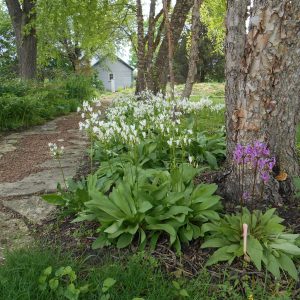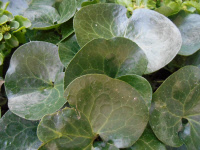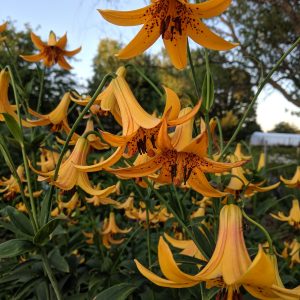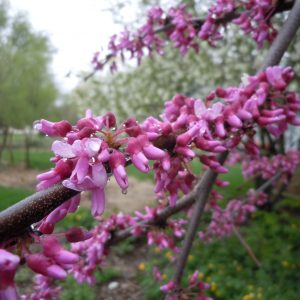…Asarum canadense Wild ginger Asarum europeum Wild quinine Parthenium integrifolium Wild senna Senna hebecarpa Wild sweet William Phlox divaricate Willow bluestar Amsonia tabernaemontana Winterberry/Wintergreen Gaultheria procumbens Winterberry holly Ilex verticillata…
More »Search Results for: Asarum canadense
-
Asarum canadense syn. Hexastylis canadense Wild ginger Z 3-7
Concealed brown bell-shaped flowers with flared tips hide under this groundcover’s crinkled, lacquered leaves....
Concealed brown bell-shaped flowers with flared tips hide under this groundcover’s crinkled, lacquered leaves.
Size: 6" x 6" spreading
Care: part shade to shade, moist well-drained to well-drained soil
Native: Canada to So. Carolina, Wisconsin nativeNative Americans used Wild ginger for such diverse purposes as flavoring food, curing heart palpitations, induce menstrual cycles, cure “the bite of the serpent,” mend broken bones, as a general tonic, a tea and lure catfish. Winnebago tenderized raccoon meat with this. Colonists used the plant to break fever and stimulate the appetite.
-
Shade Garden
ARCHIVED Note: This collection is not currently for sale. This is an archive page preserved for informational use. Shade Garden Size : Height x width* Bloom color 3 Asarum canadense...
ARCHIVED
Note: This collection is not currently for sale. This is an archive page preserved for informational use.
Shade Garden Size : Height x width* Bloom color
3 Asarum canadense – Wild ginger 6” x 6” spreading brown
3 Astilbe chinensis 24” x 24” pink
1 Brunnera macrophyllum – Siberian bugloss 18″ x 24″ blue
1 Chelone glabra – Turtlehead 2-4’ x 12” white
1 Disporum flavens – Fairy bells 25-30” x 16-20” yellow
3 Dodecatheon meadia – Shooting star 12-24” x 6-12” white
1 Hosta ‘Blue Cadet’ 35-40” x 36” lavender
1 Primula veris – Cowslip 8”x 8” yellow
3 Stylophorum diphyllum – Celantine poppy 12-18” x 12” yellow
1 Tricyrtis hirta – Toadlily 2-3’ x 2’ white & purpleAll plants are perennials.
If planted together in one garden these make a 30 square foot garden. **Most of these plants get wider over time by spreading roots or by self-seeding .
18 plants for $158.14. Would be $186.05 if purchased separately. You save $27.90.
If you plan on coming to the Nursery to purchase this collection, please give us at least 24 hours notice to prepare the collection for you.
Laugh at Walnut Trees
…Adiantum pedatum Maidenhair fern Ajuga – all – Blue bugle Alcea rosea Hollyhock Anemone – all Aristolochia durior Dutchmans pipe Asarum canadense Wild ginger Asclepias tuberosa Butterfly weed Aster –…
More »-
Asarum europaeum syn. Hexastylis europaeum European snakeroot, Wild ginger Z 4-9
OUT OF STOCK – EMAIL FOR AVAILABILITY Glossy, leathery, kidney shaped leaves, dark green with lighter veins, with purplish, sepia-toned bell-like flower, hidden by the more ornamental leaves...
OUT OF STOCK – EMAIL FOR AVAILABILITY
Glossy, leathery, kidney shaped leaves, dark green with lighter veins, with purplish, sepia-toned bell-like flower, hidden by the more ornamental leaves
Size: 4-6” x 12” slow spreader
Care: shade to part shade in moist to moist well-drained acidic soil
Native: Europe
Awards: Elisabeth Carey Miller Garden Great Plant Pick & England’s Royal Horticultural Society Award of Merit.According to Dioscorides in Roman times this plant cured ailments of the eyes, ears, stomach, mind and the head. Grown in the Eichstatt Garden, the garden of Johann Konrad von Gemmingen, prince bishop of Eichstatt in Bavaria, c. 1600. Gerard (1633) reported that this Wild ginger prevented increase of hard swelling cankers by topical application. Powdered root mixed with wine cured sciatica, gout, dropsie & ague. The name Asarum comes from Greek phrase “to adorn”, meaning it needs adornment.
-
Lilium canadense, Z 2-6
OUT OF STOCK Showy, drooping flowers from lemon to dark orange in color with conspicuous red spots on the inside....
OUT OF STOCK
Showy, drooping flowers from lemon to dark orange in color with conspicuous red spots on the inside.
Size: 2-4’ x 6”
Care: part shade in moist to moist well-drained, slightly acidic soil
Native: Upper Great Lakes & southern Canada
Wildlife Value: attracts butterfliesIntroduced to gardens from its native North America by Jacques Cartier, 1535. Also collected by Swedish botanist Pehr Kalm (1716-1779) who collected in Northeastern US and SE Canada and sent it to Linnaeus. Grown at America’s 1st botanic garden, Elgin Botanic Garden 1811. Listed in the 1873 catalog of Leichtlin’schen Gartens in Baden-Baden.
-
Cercis canadensis Red bud, Judas tree. Z 4-8
OUT OF STOCK In spring when we need a Dionysian jolt from winter’s hibernation shameless fuchsia buds appear along the tree’s stems, then Red bud’s flowers burst open before the...
OUT OF STOCK
In spring when we need a Dionysian jolt from winter’s hibernation shameless fuchsia buds appear along the tree’s stems, then Red bud’s flowers burst open before the glossy leaves unfurl.
Size: 20-30’ tall and 25-35’ wide
Care: sun to part shade and moist well drained soil.
Native: between NY northwest to Wisconsin, Florida and southwest to New Mexico. Oklahoma adopted it as its state tree.
Wildlife Value: Spring Azure, Henry’s Elfin & Great Purple Hairstreak butterflies drink flowers’ nectar. Immune to the toxin Juglone from Walnut trees.1st described by French explorer and botanist Joseph Pitton Tournefort in 1700 in Institutiones rei herbariae and he named it Siliquastrum canadense. The tree went through six different names until 1737 when Linnaeus renamed it Cercis canadensis. Collected by Colonial nurseryman John Bartram. (1699-1776) George Washington planted this at Mount Vernon. Cherokee and Delaware steeped Red bud roots and bark in water for cures of fever, stuffiness, whooping cough and vomiting. Cherokee children ate the flowers. French Canadians added them to salads.
**LISTED AS OUT OF STOCK BECAUSE WE DO NOT SHIP THIS ITEM. IT IS AVAILABLE FOR PURCHASE AT OUR RETAIL LOCATION.





